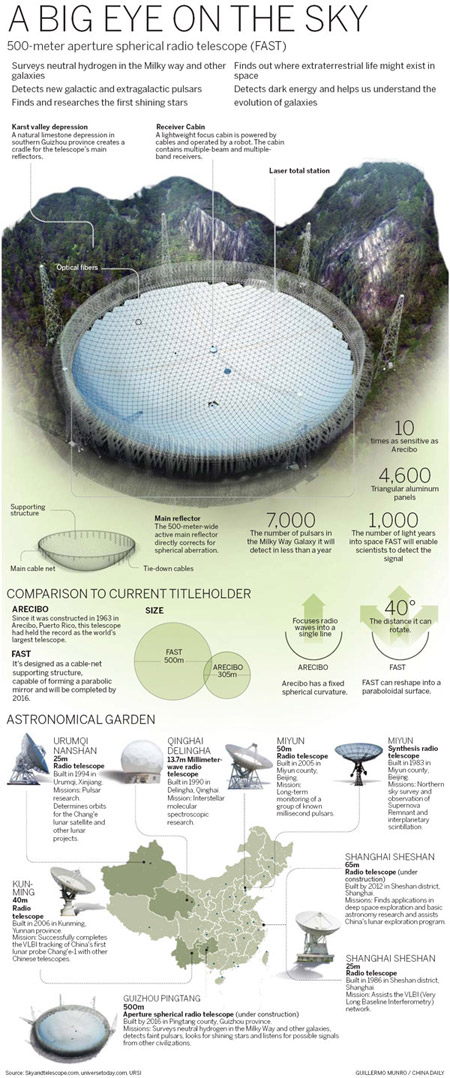To infinity and beyond

The world's biggest single dish radio telescope is expected to start operating in China's Guizhou, in just over four years. Wang Ru investigates.
China is expected to have the world's largest single dish radio telescope in September 2016.
Construction began in March 2011, in Dawodang, Pingtang county, Guizhou province.
The 500-meter Aperture Spherical radio telescope (FAST) will enable astronomers to get a jump-start on surveying neutral hydrogen in the Milky Way and other galaxies, detecting faint pulsars, looking for first shining stars and listening out for possible signals from other planets.
It will look like a huge bowl embedded in the remote karst mountains, as large as 30 football pitches. Its remote location will prevent interference from radio transmissions in populated areas.
"FAST will make possible a SETI (Search for Extraterrestrial Intelligence) survey that significantly supersedes other surveys," says Zhang Haiyan, an official from National Astronomical Observatories (NAO) in charge of the project.
"If intelligent life in the Milky Way or other galaxies sends radio signals equal to a mobile phone, FAST will be able to receive it."
FAST will also be a powerful tool for environmental research, satellite and space exploration programs, while receiving and transmitting massive amounts of data.
Additionally, it will open to the public during its maintenance periods, Zhang says.
Currently, the world's largest single dish radio telescope is the Arecibo Observatory developed by the United States in the 1960s, near the city of Arecibo in Puerto Rico, with a 305-meter-diameter aperture.
FAST will be bigger, 10 times faster and three times more sensitive. It will also cover two to three times more of the sky, thanks to the innovative design of the active primary surface.
Arecibo's fixed-dish design means it can only use 221 meters of its 305-meter dish at any one time. FAST will have the collecting power of the entire 500-meter dish, composed of 4,600 panels.
It will also be able to tilt its viewing angle 40 degrees from the vertical in all directions, Zhang explains.
The FAST concept began as the Chinese contribution to the International Square Kilometer Array (SKA), in 1993. But the SKA project will eventually find a home in either South Africa or Australia, using an array of smaller radio antennae, mimicking a single large telescope.
In 2006, China decided to go it alone with FAST and devoted funds to its construction. In October 2008, the National Development and Reform Commission, approved the project.
Costing more than 700 million ($110.95 million), it will allow international astronomers and scientists to discover more of the secrets of the universe, Zhang says.
The first radio antenna used to identify an astronomical radio source was built by Karl Guthe Jansky, an engineer with Bell Telephone Laboratories, in 1931.
In the late 1930s, American engineer Grote Reber built the first-bowl shaped radio telescope and operated it in his backyard. His radio telescope collected and measured radio waves given off by objects in space.
Radio telescopes can produce images of objects in space that would have been missed by an optical telescope. Optical telescopes need to have some kind of light to see an object, but radio telescopes don't need light to "see". Radio telescopes helped discover pulsars (collapsed stars that send out regular pulses of radio waves).
A large single-dish radio telescope is capable of observing the main components of cosmic gas and atomic hydrogen. Adhering to the principle of "bigger is better", large telescopes like Arecibo and FAST provide massive information on dark matter and the formation of stars and planets.
According to NAO, FAST should detect thousands of pulsars in the Milky Way in less than a year, which will provide exciting information on black holes.
The history of radio telescopes in China dates back to 1958, when China and the former Soviet Union co-observed an annular eclipse on Hainan Island with a small aperture solar radio telescope, made by the Soviet Union. In 1965, China had produced its first solar radio telescope.
In 1983, Miyun Synthesis Radio Telescopes, consisting of 28 nine-meter-aperture telescopes, were built in Miyun county, Beijing.
NAO was founded in April 2001 through the merger of four observatories, three observing stations and one research center, all of which were sub-organizations of the Chinese Academy of Sciences.
Over the past two decades, large radio telescopes have been built in major NAO observatories all over China, including Xinjiang, Shanghai, Beijing, Yunnan and Qinghai.
Besides FAST, a 65-meter aperture radio telescope is being built at Sheshan Observatory in Shanghai, which is expected to be completed by the end of 2012.
In the future, China will continue to join international astronomical research and radio telescope projects.
According to NAO, the Antarctic Astronomy Center of China plans to build a telescope array near Kunlun Antarctic Station of China, close to Dome-A, the highest point on the Antarctic Inland Ice Sheet.
The first "Antarctic Survey Telescope" will utilize remote and dispatch controls. Observation data will be stored on site and some of it will be transmitted to China in real time.
Meanwhile, the country also plans to build a moon-based radio telescope.
















